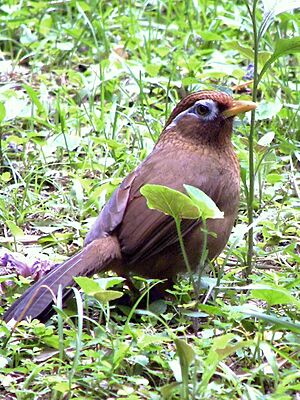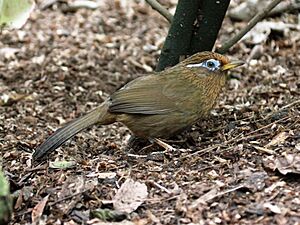Chinese hwamei facts for kids
Quick facts for kids Chinese hwamei |
|
|---|---|
 |
|
| L. c. canorum in Hong Kong | |
| Conservation status | |
| Scientific classification | |
| Synonyms | |
|
The Chinese hwamei (Garrulax canorus) is a type of bird found in eastern Asia. It's also known as the melodious laughingthrush. The name "hwamei" comes from the Chinese words 画眉 (huà méi). This means "painted eyebrow." It refers to the special white markings around the bird's eyes. This bird is a popular cagebird because it sings such a beautiful song.
Contents
About the Chinese Hwamei
How Scientists Name Birds
The Chinese hwamei was first officially described by a Swedish scientist named Carl Linnaeus. He did this in 1758 in his famous book, Systema Naturae. He first put it in the thrush group, calling it Turdus canorus. The word canorus is Latin for "melodious" or "singing." This is a perfect name for a bird known for its song!
Today, the Chinese hwamei is part of a group of birds called Garrulax. This group includes 14 different kinds of laughingthrushes.
Different Kinds of Hwamei
There are two main types, or subspecies, of Chinese hwamei:
- G. c. canorus: This type lives on the mainland of Asia.
- G. c. owstoni: This type lives on Hainan Island.
There's another bird called the Taiwan hwamei (Leucodioptron taewanum). It used to be thought of as a type of Chinese hwamei. But recent studies show it's actually a separate species. Scientists looked at their DNA to figure this out. They found that the Taiwan hwamei and Chinese hwamei separated about 1.5 million years ago. The two Chinese hwamei subspecies separated about 600,000 years ago.
Sometimes, Chinese hwameis that were brought to Taiwan have babies with the native Taiwan hwameis. This mixing could make the unique Taiwan hwamei less special over time.
What Does a Chinese Hwamei Look Like?

This bird is about 21 to 25 centimeters (8 to 10 inches) long. It has wide, rounded wings and a tail shaped like a fan. Most of its feathers are reddish-brown. It has dark streaks on its head, back, and throat.
A cool feature is the white ring around its eye. This ring continues backward as a white stripe. Its bill and feet are yellowish. The birds on Hainan Island (L. c. owstoni) are a bit lighter underneath. They are also more olive-colored on top. The Taiwan hwamei looks different. It's grayer and has more streaks. It also doesn't have the white markings on its head.
Its Amazing Song
The Chinese hwamei is famous for its song. It's loud, clear, and changes a lot. The bird often repeats parts of its song. It can even copy the sounds of other birds! Its regular call is a rough whistle or a rattling sound.
Where Do Chinese Hwameis Live?
Natural Homes
The main type of Chinese hwamei, G. c. canorus, lives in south-eastern and central China. You can also find it in northern and central Vietnam and Laos. The G. c. owstoni type lives only on Hainan Island.
New Homes
Chinese hwameis have been brought to other places by people. These are called introduced species. They now live in Taiwan, Singapore, Japan, and Hawaii. In Hawaii, they were brought there in the early 1900s. Now they live in both natural forests and places made by people. They are common on islands like Kauai, Maui, and Hawaii Island. They are less common on Oahu and Molokai.
Their Habitat
These birds like to live in scrubland and open woodland. They also enjoy secondary forest, parks, and gardens. They can live in places up to 1800 meters (about 5,900 feet) above sea level. The Chinese hwamei is quite common in most places it lives. It is not considered a threatened species.
How Chinese Hwameis Behave
The Chinese hwamei can be a bit shy. It often hides, which makes it hard to spot. It usually looks for food on the ground, among fallen leaves. It eats insects and fruit. These birds often live in pairs or in small groups.
Family Life
The breeding season for Chinese hwameis is from May to July. They build a large nest shaped like a cup. The nest is usually in a tree, bush, or among plants close to the ground. It's typically about two meters (6.5 feet) high. The female bird lays two to five eggs. These eggs are blue or blue-green.


